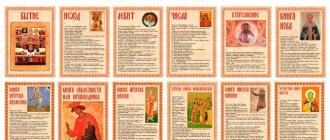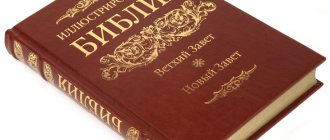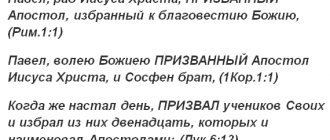The New Testament begins with the Gospel of Matthew. Does this mean that the Apostle Matthew actually wrote his book first? Or is his gospel simply the most important? Most likely, we will never know exactly in what order the four Gospels were written. There have been debates about this in biblical scholarship since the 18th century, but there is still no final clarity. However, there are many reasons to believe that the Gospel of Matthew actually came to light before the other three. But let's talk about everything in order.
How do we know that Matthew wrote the Gospel of Matthew?
But really, where from? After all, the history of literature (including Christian literature) knows many pseudepigrapha - works signed with the names of other, sometimes even fictitious, authors. And from the text of the Gospel itself it does not at all follow that it was written by the Apostle Matthew. Matthew is mentioned in passing: Passing from there [from Capernaum. – Approx. ed.], Jesus saw a man named Matthew sitting at the toll booth, and said to him, “Follow Me.” And he arose and followed Him (Matthew 9:9). And other evangelists call this tax collector a completely different name - Levi Alpheus (Mark 2:14), or simply Levi (Luke 5:27-29) ... First of all, let’s say that the concept of authorship in the Gospels is generally quite conventional. As the famous Russian theologian, Church historian and biblical scholar Nikolai Glubokovsky wrote at the beginning of the 20th century, “The Gospel as the deliverance of people from sins and the granting of salvation to them was brought by the God-man, belongs only to Him,” and only Christ Himself can be considered its Author in the proper sense. The Greek preposition κατὰ, which we usually translate as “from” (Gospel of Matthew, Mark, etc.), is closer in meaning to “according to” or “according to”: Gospel “according to Matthew”, or “according to Mark”. The evangelical apostles were not authors, but rather compilers, editors, and perhaps even partly compilers of memories of Christ. Therefore, the question of whose name is in the title is important, but not critical.
Symbol of the Evangelist Matthew.
Gospel Khitrovo. Beginning of the 15th century But as for Matthew specifically, there is quite reliable evidence from his close contemporaries about his direct participation in writing the Gospel.
What kind of evidence is this?
The first to speak about Matthew as the compiler of the Gospel was the Bishop of Hierapolis Papias (70-163). He was familiar, if not with the apostles themselves (Church historians have different opinions on this matter), then at least with their immediate circle. With the daughters of the Apostle Philip, who lived in Hierapolis. With a certain “Elder John,” in whom they sometimes see the Apostle John the Theologian. With Saint Polycarp of Smyrna, who personally met “with John and with those others who saw the Lord with their own eyes.” Papias wrote the work “Interpretations of the Sayings of the Lord,” from which only quotes have been preserved (in the “History of the Church” by Eusebius of Caesarea). There he reports that the Apostle Mark spoke about the life and teachings of Christ, accurately translating into Greek the sermons of the Apostle Peter, and Matthew “compiled the logia (Greek λόγια - sayings or, possibly, conversations. - Ed.) of Christ in Hebrew , which everyone translated as best they could.” The Hieromartyr Irenaeus of Lyons (130-202) confidently calls Matthew the compiler of the Gospel. How could he know about this? He was a student of the Hieromartyr Polycarp of Smyrna, and he, as we have already said, personally communicated with the apostles. Neither Clement of Alexandria (150–215), nor Tertullian (155/165–220/240), nor Tatian (120–185), who made perhaps the first attempt in history to connect the four, doubts the authorship of Matthew. Gospels in one. Blessed Jerome of Stridon also wrote about Matthew as the author of the first Gospel at the border of the 4th and 5th centuries. His testimony, although late, is valuable because he spent many years in Palestine, studying the local language, customs and traditions, and translating the Holy Scriptures into Latin.
Saint Jerome in his cell, Quentin Masseys
Only in the 19th century did Western biblical scholars begin to doubt that Matthew himself wrote the first Gospel. Bruce Metzger, one of the most authoritative Western biblical scholars of the 20th and early 21st centuries, was embarrassed by how “submissive” Matthew was - one of the twelve closest disciples of Christ! - follows Mark in his narrative, who was not a personal witness to most of the gospel events. Another modern scholar, Richard Bauckham, doubts that the author of the first Gospel was named Matthew. The names Matthew and Levi were among the most common in Judea at that time, and one person could not be called both at once, he explained. But both of these doubts are in one way or another connected with the assumption that the Gospel of Matthew was not the first to be written, that its author “followed in the footsteps” of the Apostle Mark. But this assumption is far from proven (there are both pros and cons). While the entire church tradition, rooted in the 1st-2nd centuries, convincingly testifies: the Gospel of Matthew was written by none other than Matthew.
NEW TESTAMENT
THE NEW TESTAMENT (Greek kaine diatheke, Latin novum testamentum) contains 27 books that make up the second part of the Christian Bible. The Greek word diatheke means "testament", "testament"; "union", "treaty". The covenant is called the New because Christians believe that Jesus Christ sealed with his blood a new (second) covenant between God and man (1 Cor 11:25; Heb 9:15) (the first was the covenant made by God with Moses on Mount Sinai) .
Also on topic:
CHRISTIANITY
Jesus did not leave behind any writings; all information given in the books describing his life and explaining the meaning of his ministry comes from his first followers, the apostles and their disciples. The first four books are called the gospels, their content is the “good news” about Jesus Christ - about his birth, ministry, expressed in preaching and in the miracles he performed, about his death and resurrection. The Acts of the Apostles, the fifth book of the New Testament, is a historical account of the asceticism of the followers of Christ in spreading the Christian faith and the growth and strengthening of the ancient church. Works of the epistolary genre are particularly widely represented in the New Testament: it includes 13 epistles of the Apostle Paul, 9 of which are addressed to various churches, and another 4 to three private individuals, as well as the anonymous Epistle to the Hebrews (attributed in the Vulgate to the Apostle Paul) and seven volumes. n. conciliar epistles, one of which is attributed to James, two to Peter, three to John and one to Judas (not Iscariot). The last book that concludes the New Testament (Revelation of John the Evangelist) belongs to the genre of apocalyptic literature: its subject is “revelation” (Greek: apocalypsis), announcing future events that are to take place on earth and in heaven. All these books are arranged in the New Testament in accordance with a natural semantic sequence: first the story of Christ and the Good News he brought is given, then the history of the spread of this message by the ancient church is outlined, then explanations and practical conclusions follow, and it all ends with a story about the ultimate goal of the divine economy .
The language in which all 27 books of the New Testament are written is Koine, the common Greek language of that era. This form of Greek, although lacking the refinement of classical Greek of the 5th–4th centuries. BC, was familiar to almost the entire population of the Roman Empire, to whom the first Christian missionaries turned to preach the Gospel. The most literary language - in terms of syntactic structure and vocabulary used - is written in the Epistle to the Hebrews and two books belonging to Luke - the Gospel of Luke and the Acts of the Apostles. Among the books that deviate most from the standards of the Attic dialect and approach colloquial Greek are the Gospel of Mark and the Book of Revelation. Moreover, since all the authors represented in the New Testament were either Jews or pagan converts to Judaism before becoming Christians, it is only natural that their Koine Greek would be influenced by their familiarity with the Septuagint, the Greek translation of the Hebrew Bible.
Also on topic:
BIBLE
The original manuscripts of the books of the New Testament have not reached us. We draw all our knowledge about these texts from three sources: Greek manuscripts dating back to the 2nd century. or subsequent centuries, ancient translations into other languages (primarily Syriac, Latin and Coptic) and New Testament quotations that are found in the works of ancient church writers.
Greek manuscripts are distinguished either by the material on which they were written (papyrus, parchment, or leather, and ostracons - clay shards) or by the method of writing. The Greek language used two types of writing: majuscule (or uncial) and minuscule. Majuscule manuscripts are written in large letters, which have much in common with modern capital letters. From the 9th century majuscule writing is being replaced by the more convenient minuscule writing, which is characterized by small, closely written letters. In the most ancient manuscripts, in accordance with the then writing rules, punctuation marks were not used and spaces were not left between individual words and sentences.
More than 50 Greek papyrus fragments of the New Testament, more than 200 Greek uncial manuscripts and about 4,000 Greek minuscule manuscripts (including lectionaries - books from which sacred texts were read during church services) are known. The oldest New Testament fragment is considered to be a tiny fragment of a papyrus codex dating from the first half of the 2nd century. and containing several verses from the 18th chapter of the Gospel of John in Greek. The oldest manuscripts containing significant parts of the New Testament are three papyrus codices dating from the 3rd century. (the so-called Chester Beatty papyri). One of them consists of 30 damaged leaves of the papyrus codex, which originally included all four gospels and the Acts of the Apostles. Another is 86 slightly damaged leaves containing the text of the ten letters of the Apostle Paul. Finally, the third contains ten slightly damaged leaves of the Book of Revelation. The two oldest parchment Greek majuscule manuscripts of the New Testament are the Codex Vaticanus and Codex Sinaiticus, dating from the 4th century. Greek minuscule manuscripts date back to the 9th century. and subsequent centuries.
As the New Testament was rewritten many times to meet the growing needs of the church, the scribes made many changes to it. Copyists not only made the unintentional errors that are inevitable in any copying, but often attempted to improve the grammar or style of the text, correct perceived historical and geographical errors, correct quotations from the Old Testament in accordance with the Greek Septuagint, and reconcile parallel passages in the gospels. As a result, numerous readings (variants of text fragments) arose, of which approx. 200,000. However, it should be noted that more than 95% of these discrepancies do not affect the understanding of the meaning of the text. Using textual methods, scientists are able to reconstruct, with a greater or lesser degree of reliability, the original text that underlay the surviving variants. Ancient translations and New Testament quotations in the writings of the church fathers are also of great help in evaluating various manuscript readings.
The number of surviving Greek manuscripts of the New Testament far exceeds the number of manuscripts of the Greek classics. For example, Homer’s Iliad has reached us in less than 500 manuscripts, the works of Plato and Thucydides in two dozen manuscripts, and we know many other authors only from a single manuscript. In addition, the works of many Greek and Latin authors are preserved only in manuscripts dating back to the Middle Ages.
The manuscripts of the New Testament were created on scrolls, and the practical impossibility of increasing their length beyond a reasonable limit prevented the combination of several books of the New Testament in one scroll. In the 2nd century. many Christians mastered the codex form, or loose-leaf book, which allowed them to collect, for example, all the gospels or all the letters of the Apostle Paul in one volume. In parallel with this process of collecting and systematizing individual New Testament books, the idea of a New Testament canon was formed.
The Greek word “canon” is borrowed from Semitic languages and originally meant a ruler or stick with which measurements could be made, and hence, in a figurative sense, “rule”, “norm” or “list”. Why, how, and when the books constituting the New Testament in its present form were collected into a single body is a question to which it is extremely difficult to answer, since the church fathers of this era do not give any definite and detailed reports on this subject. However, we can trace some trends that seem to have influenced the formation of the New Testament canon.
Jesus and his first followers received from the Jews the authoritative body of Holy Scripture - the Hebrew Bible. In addition, since the listeners treated with special reverence and respect the sayings of Christ himself, who said that in him the Old Testament was fulfilled and received its final meaning, the practice of reading excerpts from books in which the words were set forth began to develop in the ancient church during general services. and the actions of Jesus. But even before the gospels were written, Christians read the letters of the Apostle Paul addressed to a given church (community). These messages were also sent to neighboring communities (Col. 4:16). Paul's letters, like those of the other apostles, were intended to be read over and over again before an assembly of believers. It can be assumed that they were initially perceived as a written sermon by a teacher who could not personally address his flock. Over time, it became customary to listen to the apostolic words, and they were circulated in copies, and subsequently came to be regarded as Scripture. Later, when heretical sects began to arise in large numbers, each of which had its own “scripture,” the Orthodox Church had to more clearly define the boundaries of the true canon. Around 140, the heretic Marcion formed his own canon of scripture, excluding the Old Testament and leaving only the Gospel of Luke (in an abridged form) and the epistles of the Apostle Paul (with the exception of two epistles to Timothy and the Epistle to Titus).
During the second half of the 2nd century. the church - according to such authoritative writers as Irenaeus, Tertullian and Clement of Alexandria, familiar with the situation in Asia Minor and Gaul, North Africa and Alexandria - became aware of the fact that it had a canon, which included the four gospels known to us, the Acts of the Apostles , 13 Epistles of Paul, 1st Peter and 1st John. Seven books - the Epistle to the Hebrews, the Epistle of James, the Second Epistle of Peter, the Second and Third Epistles of John, the Epistle of Jude and the Book of Revelation - have not yet received universal recognition, and a number of others (in particular, the Didache, the Epistle of Barnabas, the Shepherd of Hermas and the Apocalypse Peter) were placed as if on the border of the canon. In the 3rd century. and at the beginning of the 4th century, as can be judged from the writings of Origen and Eusebius, all near-canonical books were examined and a classification of texts claiming apostolic authority was carried out, as a result of which genuine, dubious and rejected (they were called apocryphal) books were identified. Although Origen still referred to the Shepherd of Hermas and the Epistle of Barnabas as “scriptures,” it is significant that among his many interpretations there is not a single interpretation of a book that would not be included today in the New Testament canon.
In the 4th century. The composition of the canon begins to be consolidated in official decrees - first by the bishops of local churches, and then by local and ecumenical councils. This composition is increasingly approaching - in the number and arrangement of books - the composition of the New Testament that we know today. Athanasius of Alexandria was the first who, in his 39th Feast Epistle (367), gave a list of the modern 27 canonical books of the New Testament (placing, as is still customary in the Orthodox tradition, the conciliar epistles before the epistles of the Apostle Paul). In the West, the 27 canonical books of the New Testament were recognized by the Latin Church at three African councils, at which Augustine played a leading role (at the Council of Hippo in 393 and at the two Councils of Carthage - in 397 and 419). With the advent of Jerome's Latin Vulgate, this canon was recognized everywhere in the West. In the East, the Syrian Church back in the 5th century. recognized only 22 books as canonical, not including the Second Epistle of Peter, the Second and Third Epistles of John, the Epistle of Jude and the Book of Revelation in the New Testament part of the Syriac translation of the Bible (Peshitta). The Ethiopian Church, on the contrary, included 35 books in its New Testament, recognizing 8 books of the so-called canonical. Apostolic Decrees.
None of the councils, whose authority was recognized by the entire church, made decisions regarding the limits of the canon. In 1546, the Council of Trent clearly defined the canon for Roman Catholics, and in the encyclical Providentissimus Deus (1893), the general Christian doctrine of the inspiration of canonical books was formulated - in terms accepted in Catholicism. The canonicity of individual books was assessed according to certain criteria, the main of which were their apostolic origin (or the presence of apostolic sanction), their agreement with the Old Testament and other parts of the New Testament, and the wide distribution of these books.
Did this Hebrew text even exist if it has not survived to our times?
The assumption that the Gospel of Matthew was written immediately in Greek was born only at the beginning of the 16th century: this version was expressed by the famous humanist scholar and biblical scholar Erasmus of Rotterdam and the Catholic Cardinal Cajetan. Developing this line of thought further, Protestant scholars eventually suggested that Matthew was not the first to write (a well-known supporter of this hypothesis was, for example, the German theologian Heinrich-Julius Holtzmann, who lived in the 19th and early 20th centuries). But, firstly, the existence of a Jewish original is evidenced by many church writers of the 4th centuries. These are the already mentioned Papias of Hierapolis and Irenaeus of Lyons, and Eusebius of Caesarea, who wrote his “Church History” during the time of Emperor Constantine the Great (mid-4th century). According to his information, at the end of the 2nd century, the Egyptian Christian theologian Panten, the founder of the later famous Alexandria School, discovered the Hebrew text of the Gospel of Matthew ... in India, where the Apostle Bartholomew, who preached there, brought it a century earlier! “This news is dear to us because it cannot be deduced from Papias and gives us new, independent and independent evidence about the original Hebrew language of Matthew’s writing,” notes Glubokovsky. In addition, some Hebrew text was kept, according to the testimony of Jerome of Stridon, in the library of Caesarea in Palestine. Blessed Jerome wrote that he personally “had the opportunity to copy this Gospel from the Nazarenes, who in the Syrian city of Berea use this book.” Whether it was the original, or the “Gospel of the Jews” created on its basis and popular among Jewish Christians is now impossible to tell. The text was subsequently lost.
Tables of canons (fragments of the Gospels) by Eusebius of Caesarea, compiled in the 5th century on the basis of the Diatessaron of Ammonius of Alexandria.
Well, secondly, the Greek text of the Gospel of Matthew known to us has characteristic features that convincingly indicate the existence of a Jewish prototype. Researchers consider, for example, the words of the Archangel Gabriel addressed to the righteous Joseph as a clear echo of the Jewish original: You will call His name Jesus, for He will save His people from their sins (Matthew 1:21). They become understandable only in the Hebrew original, where “Jesus” means “God saves.” Describing the crucifixion of Christ, Matthew quotes His cry in Hebrew: Either, Or! Lama Savakhthani? that is: My God, My God! Why have you forsaken me? (Matthew 27:46) Without this cry, it would remain incomprehensible why those around him mocked the Crucified One, saying: He is calling Elijah (Matthew 27:47). (The Gospel of Mark contains the same exclamation, however, but this is understandable if we consider that the Apostle Mark wrote after Matthew and partially used his work.) Another feature of the Gospel of Matthew is the abundance of references to Old Testament prophecies about Christ. Moreover, Matthew is the only one who borrows these prophecies not only from the Greek Bible - the Septuagint (like other evangelists), but also from the Hebrew text. For example, in the wording of the original Hebrew, not the Septuagint, the commandment is given: You shall love the Lord your God with all your heart (Matt. 22:37), and this is not the only case.
Introduction
Introduction to the New Testament began to develop as an independent branch of scientific research only in the 18th century. Church writers and fathers did not specifically deal with issues of isagogy, except sometimes in prologues to their commentaries on biblical books, the so-called ύποθέσεις, or in polemical treatises against heretics. We find some information on isagogy from Papias, bishop of Hierapolis of Phrygia (about 130 AD), in those fragments of his writings that were preserved by the historian Eusebius of Caesarea. In addition, Saint Irenaeus of Lyons, Tertullian, Saint Clement of Alexandria, Origen, the already mentioned Eusebius, Bishop of Caesarea in Palestine, Blessed Jerome and others dealt with issues of isagogy. The first introduction to the New Testament books, albeit the briefest, can be considered the canon of Muratori (end of the 2nd century BC). according to R.H.), which contains a list of the books of the New Testament with brief information about each of them. The anti-Marcionite prefaces to the Gospels of Mark, Luke and John date back to approximately the same era, preserved in 38 ancient Latin manuscripts of the Gospels, of which the preface to the Gospel of Luke is also preserved in Greek. For the first time, the term “Introduction to the Holy Scriptures” was used by Hieromonk Adrian of Antioch3 (450 AD), who meant by this an introduction to interpretations of the Holy Books rather than an introduction to their historical and philological problems.
The father of isagogy in modern times is considered to be the Frenchman, a member of the Oratorian order, Richard Simon (1638–1712). With his trilogy “Critical history of the text of the New Testament” (1689), “Critical history of translations” (1690) and “Critical history of the main interpretations of the New Testament” (1693), he isolated the New Testament isagogy from the general isagogy of the Holy Scriptures and opened the way for critical study of the text of the New Testament, laying the foundation for historical and philological analysis. Despite the fact that the works of R. Simon met with sharp opposition (he was expelled from the order, ten of the books he wrote were included in the register of prohibited reading), he is currently considered the father of New Testament isagogy.
A notable milestone in the field of isagogy was the Tübingen school led by Ferdinand Bauer in the 19th century. Bauer applies Hegel's dialectical scheme (thesis - antithesis - synthesis) to the history of early Christianity. He distinguishes between the Judaizers, led by Peter (thesis), and the opposite movement, led by Paul, who taught freedom from the Law of Moses (antithesis). As a result of the confrontation between these two directions, according to Bauer, a synthesis of the 2nd century occurred. Bauer recognized as genuine books of Holy Scripture only those that carry an echo of the polemics of these two movements (for example, the Epistles to the Romans, Galatians, First and Second Corinthians and the Apocalypse). Whereas he considers those New Testament books that presuppose their peaceful coexistence to be the works of the united Church of the 2nd century (for example, Acts, Gospels, other apostolic letters). These views of the Tübingen school met with serious objections already from the end of the 19th century, since it was quite rightly noted that they fit the events of church history into a pre-selected artificial scheme.
In the 20th century, several schools of biblical studies dominated. The school of “history of religion” (Wilhelm Busse5, Alfred Loisy6 and others): through the study of similar ideas and cult practices of other religions, some supporters of this school tried to present Christianity as only the result of the development of other religions. Other followers of the “history of religion” school, recognizing the similarities only in external manifestations, emphasized the significant difference between Christianity and other faiths. The “eschatological school,” represented by its representatives Johann Weiss7 and Albert Schweitzer8, placed emphasis in the teaching of the Savior on the expectation of future events, while Charles Dodd9 put in first place those teachings where the Kingdom of God is described as an already arrived reality. Finally, the school of “history of forms” (Rudolf Bultmann10, Martin Dibelius11, Karl Schmidt12) studied the prehistory of the Gospel tradition, and the school of “history of editions” paid special attention to the peculiarities of the theology of each of the evangelists.
The theory of “demythologization” of the New Testament, proposed by Bultmann shortly after World War II, excited the scientific world for a whole decade with constant disputes between its ardent supporters and opponents. This theological dialogue extended beyond the boundaries of the Protestant world in which it originated, involving Orthodox and Catholic theologians, and its influence was felt for three decades after the Second World War.
After this theory, not directly related to it, new directions appeared one after another within the framework of New Testament biblical studies, such as, for example, the concept of the social Gospel, stylistic analysis, structural analysis, feminist direction and others, while none of them was able to take precedence positions13.
Septuagint
The name of the translation of the books of the Old Testament into Greek, carried out in Alexandria, Egypt, starting in the 280s. BC By the time of Christ’s earthly life, this translation was in wide circulation and enjoyed authority throughout the Roman Empire, which spoke predominantly Greek. Even Palestine was no exception: after all, the original text of the Old Testament was written in Hebrew, which not all Jews knew - this is evidenced by the fact that there was a position of translator in synagogues. Even Josephus, the famous Jewish historian of the 1st century AD, constantly referred to the Septuagint when quoting the Bible. Linguistics experts find other features in the text of the Gospel of Matthew that are difficult to explain if the presence of a Jewish prototype is denied. For example, Matthew often uses the particle ἰδού, which is not very characteristic of the Greek language (in Russian translation - “behold” or “here”). It appears to be simply a Greek tracing of the polysemantic Hebrew word hinnê. Or an expression such as “having answered, he said” (Matthew 21:21): in Greek - as in Russian - it sounds heavy, but it literally corresponds to a common Hebrew phrase.
Where are the original Bible books kept?
The “authentic” text of the Bible was compiled through painstaking research from many ancient manuscripts stored in museums and libraries.
However, oddly enough, today the text of many books of the Bible is more reliable than the works of such ancient authors as Homer, Aeschylus or Plato, preserved only in manuscripts of the 9th-11th centuries. according to R. X. - i.e. in texts written down 1400-1700 years after the creation of the original, while the manuscripts that formed the basis of the Bible are separated from the original sources by a much shorter time frame. In total, according to 1989 data, the following number of different cataloged types of ancient New Testament manuscripts is known:
Papyri (This was the "poor man's" writing material, and before it was used as a codex (in the form of a book), it was used like a scroll, written on both sides) - 96
Uncial manuscripts (Codices and parchment scrolls on which the text is carved in large (capital) letters of the Greek alphabet) - 299
Minuscule manuscripts (or cursive scripts written in Greek capitals and dating from the ninth to the sixteenth centuries) - 2812
Lectionaries (Service books for church worship. These texts contain “lessons” or “passages” from Scripture.—2281
Total - 5488
For comparison, I will give the number of surviving manuscripts of the works of some ancient authors: only 2 manuscripts have reached our time from Euripides, 1 from the Annals of Tacitus, 11 from Plato, 50 from Aeschylus, about 100 from Virgil and Sophocles.
Codex Sinaiticus. All of them are dated (palaeographically, that is, based on the “handwriting style”) to the 4th century. AD The language of the codes is Greek. As a result of the analysis of these codes, the main text of the New Testament was developed, accessible to every theologian.
Vatican Codex - came to the Vatican around 1475, the first mention of it in the Vatican Library dates back to 1481. Before that, its history is vague. It was written in the period 350-370. AD, presumably in Italy, and has been preserved in good condition for eleven centuries. This manuscript is written on fine parchment (i.e. tanned animal skin) and contains 759 pages, measuring 10/10.5 inches (or 25.4/26.6 cm), each containing three narrow columns of forty-one lines in each column. 8 The manuscript includes the Epistle to Barnabas and the Apocrypha. According to Tischendorf, the Vatican manuscript was written by the same person who wrote Sinaiticus, however, the Pope claims that Sinaiticus (Aleph) was written earlier, judging by the sections in the Gospels. 11 The missing passages in the Vatican manuscript are: Genesis 1:1 to Genesis 46:28, Psalm 106 to Psalm 138, Heb. Matthew 16:2-3, Romans 16:24, Paul's Epistles, Revelation, and Hebrews 9:14.
The Codex of Alexandria was presented to the English king Charles I in 1628 by Patriarch Cyril Lucaris. It is written on 733 sheets of parchment, measuring 26.3/31.4 cm, in two columns with the text of Scripture, forty-one lines each. 24 It does not contain passages of John. 6:50-8:52; 2 Cor. 4:13-12:6; 1 Kings 12:20-14:19; Matt. 1:1-25:6; Genesis 15:1-5; Life 14:14-17 and Genesis 16-19. It also contains the remains of the "Epistle of Clement" (presumably dating from 95-100 AD). It was approximately written around 400-450 AD.
The Codex Sinaiticus was discovered in the 19th century by Konstantin Tischendorf, and this story deserves a separate story. Its parchment is inferior in thickness to the parchment of the Vatican manuscript. This is the only uncial manuscript that contains almost the entire New Testament (except John 5:4, 8:1-11; Matt. 16:2-3; Rom. 16:24; Mark 16:9-20; 1 John 5 :7; Acts 8:37). It also transfers the books "The Shepherd of Hermas" and "The Epistle to Barnabas" into the New Testament, and originally it still contained part of the book "Didache". It was written around 350-370. AD on 147 and a half sheets of parchment, four columns of forty-eight lines on each page. 13 Each page measures 15/13.5 inches (38/34.3 cm).
Passages have been found from New Testament writings that are older than Codex Sinaiticus. So, in December 1945 in Upper Egypt, near the ancient settlement of Henoboskion (modern Nag Hammadi region), local peasants accidentally discovered an ancient library containing books of the New Testament dating back to the 2nd-4th centuries.
The most ancient “physical evidence” is a piece of papyrus the size of a palm, discovered in Egypt in 1920 by Dr. B. Grenfell, who, however, did not attach much importance to it. Only in 1934, another scientist, Dr. S. H. Roberts, while sorting through the papyri of the so-called Manchester library of D. Ryland (owner of the papyri collection), drew attention to it. After research, he realized that he had found an ancient papyrus containing verses from the Gospel of John and dating back to about 125 AD and, therefore, about 30 years younger than the original, compiled around 95 AD. The papyrus was not found in Palestine, the birthplace of the original, and in the sands of the Egyptian desert, which gives an opportunity to imagine how quickly the New Testament writings spread.
With the Old Testament it is more difficult.
Before the discovery of the Qumran scrolls (2nd century BC), the oldest Jewish manuscripts were a manuscript from the British Museum (895 AD), two manuscripts from the Leningrad Public Library (916 and 1008 AD). ) and a manuscript from Aleppo (Code of Aaron Ben-Asher) - 10th century AD... Moreover, only a document from 1008 AD contained the entire Old Testament Bible, although manuscripts from a later time, mainly the mid-13th century AD, were kept in many national book depositories. That is why the Qumran find became a sensation. But an even greater sensation was that the research did not reveal any significant differences between the texts! The book of Isaiah in the Bible we know absolutely corresponds to the list that goes back two thousand years.
Today, the oldest text of the Old Testament is considered to be two damaged silver sheets measuring 97x27 and 39x11 mm, found in the First Temple tomb, Kitevhinnom, located in the valley with the famous name - Heichen - or fiery hell. . This text of sacred blessing from the Book of Numbers is 500 years older than the biblical scrolls found at Qumran.
There is another fact of great importance - the Hebrew written language initially had neither vowels (except A) nor signs replacing them... The books of the Old Testament were written almost exclusively with consonants.
Imagine how accurate a letter written with only consonants can be in our time, when, for example, KRV can mean: blood, crooked, blood, cow, etc. and so on.
At first, the alphabet of Hebrew, like other West Semitic languages, contained only consonants (for example, in the oldest Hebrew inscription yet found, the so-called Gezer calendar, carved about three centuries after Moses, the word for “harvest” - “katzir” - is rendered only three root consonants). In order to avoid the difficulties of reading that inevitably arose as a result, some of these consonants (in particular “ayn”) were also used as vowels close in sound to them. At the second stage (starting from the 10th century BC), this sporadic use of consonants as vowels was expanded - first in Aramaic, and then in Hebrew itself, not one or two, but four whole consonants began to be used for the same purpose: Vav, aleph, jud and hey. But this turned out to be insufficient, since these letters simultaneously remained consonants, each of them represented more than one vowel, and, finally, there was no unambiguity and systematicity in their use. Therefore, in the VI-VIII centuries AD. e. a system of so-called diacritics (dots and dashes under and above letters) was invented, which we today call “vocalization” or “nekudot system”.
So, if we now take the Hebrew Bible or manuscript, we will find in it a framework of consonants filled with dots and other signs indicating the missing vowels. But these signs did not belong to the Hebrew Bible... The books were read one consonant at a time, filling them with vowels... to the best of their ability and in accordance with the apparent requirements of meaning and oral traditions.
It is assumed that “this serious defect in the Hebrew Bible was not eliminated until the 7th or 8th centuries AD,” when the Masoretes revised the Bible and “added ... signs to replace vowels; but they had no guidance except their own judgment and tradition.”
Previously it was believed that vowels were introduced into the Hebrew text by Ezra in the 5th century BC. ... When in the 16th and 17th centuries Leviticus and Capellus in France refuted this opinion and proved that vowel signs were introduced only by the Masoretes ... this discovery became a sensation throughout Protestant Europe. It seemed to many that the new theory led to the complete overthrow of religion. If vowel signs were not a matter of divine revelation, but were only a human invention and, moreover, of a much later date, then how could one rely on the text of Scripture? ...
If the vocalization of everyday words is not so important, then the situation changes radically when a combination appears in an ancient text meaning the name of a city, country, name. For example, the Name of God.
That is why the first Greek translation of the Old Testament, the Septuagint, acquired great importance, made at a time when Hebrew was still a living language, although the translation often did not always convey the nuances. For example, in the well-known name Jesus, only one sound remains from the original sound - [y]. More details
Septuagint and Bible translations.
Legend tells that King Ptolemy II Philadelphus (285-246 BC), having learned from Demetrius of Phaleron, who was in charge of the royal book depository, about the existence of the Scriptures of Moses in Judea, decided to organize the translation of the Law into Greek and the delivery of books to the Library of Alexandria .
To this end, Ptolemy sent a letter to the Jerusalem high priest Eleazar: “Wanting to please all the Jews living on earth, I decided to begin translating your Law and, having translated it from Hebrew into Greek, place this book among the works of my library. Therefore, you will do well if you choose six elderly men from each tribe, who, due to the length of their studies in the laws, are very experienced in them and would be able to translate it accurately. I believe that this work will earn me the greatest glory. Therefore, I am sending you for negotiations regarding this […] Andrei and Aristaeus, who both enjoy the greatest honor in my eyes.”
In response, the high priest sent the king seventy-two learned scribes, six from each of the twelve tribes of Israel. These seventy-two men settled on the island of Pharos, where each of them translated the entire text of the Pentateuch alone within 72 days. Not only did they complete the translations at the same time, but all the resulting texts sounded exactly the same! After which the translation received its name - the Septuagint or “Translation of the Seventy.” (Philo. Life of Moses. 2; Josephus. Jewish Antiquities. XII.2; Justin (?). Exhortation to the Hellenes. 13; Irenaeus. Against Heresies. III .15; Clement of Alexandria. Stromata. I - II).
This entire story is based on a work known in literature as the Letter of Aristaeus to Philocrates, the falsity of which is currently beyond doubt. (It was compiled no earlier than the middle of the 2nd century BC.)
In reality, however, everything happened somewhat differently. In the last centuries before the beginning of the new era, many Jews lived in Egypt, especially in Alexandria, founded by Alexander the Great in 332 BC. They spoke Greek, and therefore there was a need for its translation. So in the 3rd century. BC began to translate the Old Testament writings, completed only in the next century.
However, no one today can provide a manuscript of the Old Testament in Greek dated earlier than 300 AD. AD The earliest manuscript that can be called a translation of the Old Testament into Greek is the Ryland Papyrus (no. 458), which contains several chapters from Deuteronomy 23-28. But even this piece of papyrus dates back to 150 BC. There is only one mention of the Pentateuch, translated into Greek under Ptolemy of Philadelphia. (Eusebius (260-340) quotes Aristovelius (Praep. Ev. XIII 12,664b).
And one more note. In those days, a book was often named after its first significant word. The first book of Moses, written in the original Hebrew, begins with the word “bereshit” (“In the beginning”). In the Greek version of the Bible, the Hebrew tradition of using initial words as titles was broken and descriptive titles were used. Thus, the First Book of Moses received the name “Genesis” (in the Church Slavonic tradition - Genesis), translated from Greek - “origin”, although in the Hebrew original it begins with the word “bereshit” (“In the beginning”).
In the first Christian centuries, new translations of the Bible appeared (into the languages of other peoples of the Roman Empire). In the middle of the second century AD, the Old Testament was translated into Syriac - this is the so-called Peshitta, or Peshitto, that is, simple. The oldest currently known manuscript of the Peshitta dates back to the beginning of the 5th century. In our time, Peshitta has two traditions - Western and Eastern.
The first Latin translation began to circulate before 210 AD. and (like the Byzantine Receptus in Greek) it was the work of the direct efforts of African Christians. The most famous Latin translation, the Vulgate Vernacular, was begun in 386 AD by the scholar Jerome and completed by him in 405. In 1546, the Council of Trent declared the Vulgate to be the authentic text of the Bible. In 1589, under Pope Sixtus V, and then in 1592, under Pope Clement VIII, the final version of the Vulgate was published and accepted by the Catholic Church as the official text of the Bible.
The first Bible in German dates back to the 4th century, translated by Ulfila, the “apostle of the Goths,” who had to create a Gothic script for this. So Ulfila's Bible simultaneously became the first monument of Gothic writing. A particularly valuable copy of the Gothic Bible—purple-tinted parchment with silver and gold script—is preserved today in the Swedish city of Uppsala, Sweden.
Translations of the Old Testament into Aramaic were also undertaken - the so-called Targumim (translations). The most authoritative of them are: Targum Onkelos (translation of the Torah) and Targum Jonathan (translation of H'biim, attributed to Jonathan ben Uziel).
Interesting is “HEXAPLA” - a book written by Origen Adamantius (184-254 AD), which contained six translations of the Old Testament. These six translations were arranged in vertical columns, with three additional translations appearing at times after the sixth column. The first column was the Old Testament in Hebrew.
There is great difference of opinion among "theologians" as to which Hebrew text Origen used. The SECOND column "Hexaples" is a Greek transliteration of the Old Testament, which used Greek letters to reproduce the Hebrew text. This was followed by the translation of Aquilla (95-137 AD), the translation of Symmachius (160-211 AD), the translation of Origen himself (184-254 AD, sometimes this column called a revision of some copy of the Septuagint). and finally, the translation of Theodosius (140-190 AD)…
Basically everyone agrees that the fifth column of the Hexapla (which Origen himself wrote!) represents an older and more advanced Hebrew text than that presented in the FIRST column. But since the only available copy of this manuscript was written 125 years after the death of Origen, theologians find it difficult to show the connection. This “public opinion” is similar to the opinion of people regarding some authority that they would like to get rid of.
In the history of the Church, tendencies have arisen more than once to recognize one or another translation as divinely inspired and the only acceptable one. This tendency was especially evident in relation to the Septuagint and the Vulgate. But gradually the leadership of the churches came to the idea of the need for a certain pluralism, although the category of church-approved, generally accepted, seemingly canonical translations was preserved.
The Bible came to Rus' along with Christianity. Its translation into Old Church Slavonic was carried out from Greek according to the Septuagint (Lucian review, c. 280 AD) by Cyril and Methodius (IX century); it has not been completely preserved. Already in 1056 - 1057. The so-called Ostromirovo Gospel (“Gospel-aprakos”) was copied from the Eastern Bulgarian original. Then the Arkhangelsk (1092), Mstislavovo (1117), Yuryevsk (1120), Galician (1144) and Dobrilovo (1164) Gospels appeared.
In the second half of the 15th century, the cross-Jew Theodore translated the Psalter and the Book of Esther from Hebrew; He probably also edited the Old Slavonic translations of the Pentateuch and the Prophets.
At the end of the 15th century, Novgorod Archbishop Gennady undertook the “collection” of the complete text of the Bible, and some books were translated from the Vulgate (First and Second Books of Chronicles, First and Third Books of Ezra, the books of Nehemiah, Tobit, Judith, Esther, Wisdom of Solomon, the Books of Maccabees and partly the book of Jesus son of Sirach). This tradition was followed by the Ostrog edition of the Bible (1581), but during its preparation a number of books were newly translated from Greek. In 1663, the Ostrog edition with some editorial amendments was reprinted in Moscow - the Moscow Bible. Subsequently, the Elizabethan Bible was published with some corrections (1751, 1759... 1872... 1913).
In 1680, the “Rhymed Psalter” by Simeon of Polotsk (1629 - 1680) was published in Moscow; in 1683, the translator of the Ambassadorial Prikaz, Abraham Firsov, also translated the Psalter into Russian, but this translation was immediately banned by Patriarch Joachim.
By 1698, Pastor I.E. Gluck had prepared a complete translation of the Bible into Russian, but during the Northern War, when Russian troops captured Marienburg in 1703, where Gluck lived, this work was lost.
In 1812, the Russian Bible Society was organized in Russia, which in the 20s of the 19th century published translations into Russian of some books of the Bible (the Psalter, partly the Pentateuch). In November 1825, Alexander I banned the publication of these translations, and in 1826 the activities of the Russian Bible Society ceased.
The Synod rejected all translations of the Bible into Russian, and only in 1856 did it raise the question of the need for translation. This work began in 1860, and in 1867 a conference of the Kyiv, Moscow and Kazan Theological Academies reviewed and collated all the material. The result of the work was the publication in 1868 - 1872 of the Synodal translation of the Bible, which became canonical for the Russian Orthodox Church.
In English-speaking countries, the Bible is mainly used by King James I, who in 1611 commissioned 52 scholars to create an English translation of the Bible for the needs of English-speaking Protestants.
www
Is there any other evidence that Matthew's Gospel came first?
First of all, these are the same testimonies of the early Church. Irenaeus of Lyon confidently wrote that Matthew wrote his Gospel before the other apostles. Clement of Alexandria knew or assumed that the first Gospels appeared with genealogies - lists of the earthly ancestors of the Lord Jesus Christ, that is, the Gospels of Matthew and Luke. In general, the traditional church view was expressed at the beginning of the 5th century by Blessed Augustine of Hippo: Matthew wrote his Gospel first, Mark and Luke relied on it, and John complemented what the evangelist predecessors were silent about.
Numbers
There are 27 books in the New Testament
- book 4
books, descriptions of the life and ministry of Jesus Christ (Gospel) - book
History of the emergence and development of the first Church (Acts of the Holy Apostles) - book
Instructions, letters (epistles of the Apostles),
21
books - book
Prophecy of the last days (book of Revelation)
The New Testament contains: the text of the 3rd edition of the Greek New Testament of the United Bible Societies
:
- done 138,015
Greek words - done 7,959
verses - done 259
chapters
Is this view supported by scientific data?
It has been established, in any case, that in the era of the ancient Church the Gospel of Matthew was the most famous and authoritative. Church writers of the 1st-3rd centuries quote it much more often than the texts of other evangelists. The compilers of the publication Biblia Patristica (a collection of biblical sayings ranked by frequency of citation in the works of the holy fathers) calculated that the Gospel of Matthew was quoted by authors of that era 3550 times, from Luke - 3250, from John - about 2000, and from Mark - only 1460. Excerpts Paul's companion Barnabas (late 1st century) cites from Matthew's Gospel. In particular, he calls on Christians to watch themselves as carefully as possible, so that it does not turn out that many are called, but few are chosen (Matthew 22:14). Clear parallels with Matthew are also visible in the epistles of the Hieromartyr Ignatius the God-Bearer: for example, at the beginning of the Epistle to the Smyrnae he writes that Christ “was baptized by John, so that all righteousness might be fulfilled by him,” almost verbatim reproducing the words of Christ in the Gospel of Matthew (Matthew 3:15).
The beginning of the Gospel of Matthew.
Codex No. 274 from the monastery of St. John the Evangelist (Fr. Patmos), 12th century In the Christian monument of the late 1st or early 2nd century, “The Teaching of the Twelve Apostles” (“Didache”), the prayer “Our Father” is given in the same form as in Matthew (Matthew 6:9- 13). The words of the Savior are also quoted: Do not give holy things to dogs, which are found only in the first Gospel (Matthew 7:6). In short, we have more than enough reasons to trust the conclusion of St. Augustine.
When was the Gospel of Matthew written?
And are any early manuscripts extant? According to Irenaeus of Lyons (who, we recall, lived in the second half of the 2nd century), “Matthew published the scripture of the Gospel among the Jews in their own language, while Peter and Paul preached the gospel in Rome and founded the Church.” The Apostle Paul arrived in Rome, it is believed, around the year 62, which means that the Gospel of Matthew (at least its Jewish prototype) appeared around this time. Nikolai Glubokovsky proposed to “push back” the date of its writing several years ago. He explained: in 59, the Apostle Paul came to Jerusalem and of all the apostles he found there only James with several elders (priests) (Acts 21:18-19). This means that the other apostles, and Matthew among them, had already gone to preach in other lands - and the Gospel by this time, most likely, had already been written, he reasoned. As for manuscripts, one of the most ancient documents depicting fragments of the Gospel of Matthew is considered to be papyrus, known to archaeologists and biblical scholars under the designation P45. It was created, according to modern dating, in the first half of the 3rd century. Initially, these were bound sheets of papyrus measuring 254 by 203 mm, on which the texts of all four Gospels and the Acts of the Apostles were written. Now, out of 220 leaves, only 30 remain, and mainly fragments of Acts (13 leaves), the Gospels of Mark (6) and Luke (7) have survived. The texts of Matthew and John's Gospels are represented by only two fragmentary leaves.









